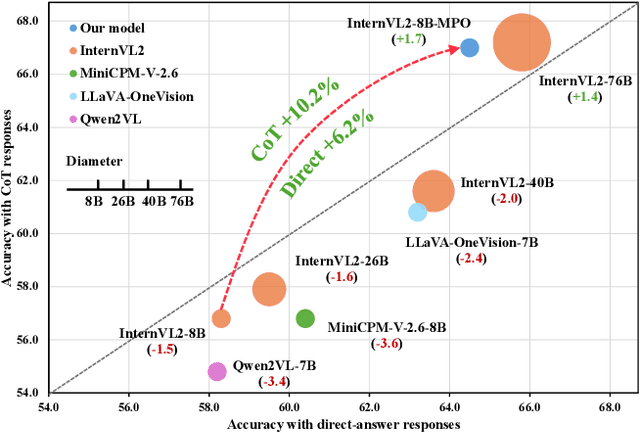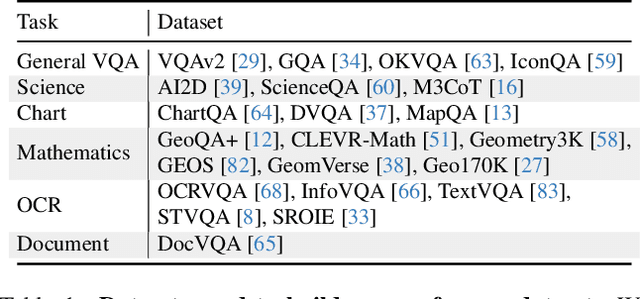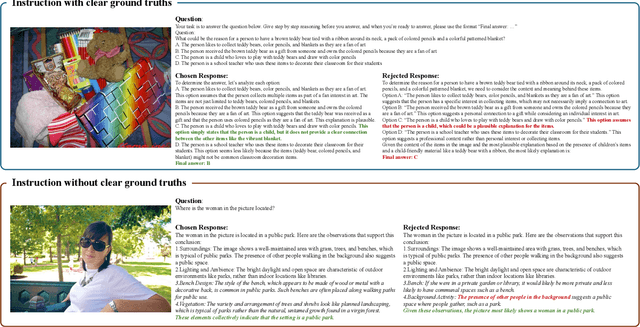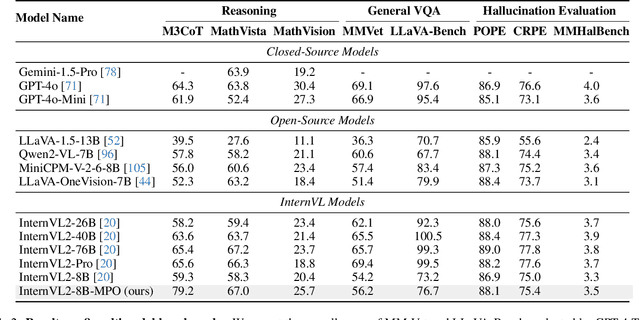Yangzhou Liu
VisualPRM: An Effective Process Reward Model for Multimodal Reasoning
Mar 13, 2025Abstract:We introduce VisualPRM, an advanced multimodal Process Reward Model (PRM) with 8B parameters, which improves the reasoning abilities of existing Multimodal Large Language Models (MLLMs) across different model scales and families with Best-of-N (BoN) evaluation strategies. Specifically, our model improves the reasoning performance of three types of MLLMs and four different model scales. Even when applied to the highly capable InternVL2.5-78B, it achieves a 5.9-point improvement across seven multimodal reasoning benchmarks. Experimental results show that our model exhibits superior performance compared to Outcome Reward Models and Self-Consistency during BoN evaluation. To facilitate the training of multimodal PRMs, we construct a multimodal process supervision dataset VisualPRM400K using an automated data pipeline. For the evaluation of multimodal PRMs, we propose VisualProcessBench, a benchmark with human-annotated step-wise correctness labels, to measure the abilities of PRMs to detect erroneous steps in multimodal reasoning tasks. We hope that our work can inspire more future research and contribute to the development of MLLMs. Our model, data, and benchmark are released in https://internvl.github.io/blog/2025-03-13-VisualPRM/.
Expanding Performance Boundaries of Open-Source Multimodal Models with Model, Data, and Test-Time Scaling
Dec 06, 2024



Abstract:We introduce InternVL 2.5, an advanced multimodal large language model (MLLM) series that builds upon InternVL 2.0, maintaining its core model architecture while introducing significant enhancements in training and testing strategies as well as data quality. In this work, we delve into the relationship between model scaling and performance, systematically exploring the performance trends in vision encoders, language models, dataset sizes, and test-time configurations. Through extensive evaluations on a wide range of benchmarks, including multi-discipline reasoning, document understanding, multi-image / video understanding, real-world comprehension, multimodal hallucination detection, visual grounding, multilingual capabilities, and pure language processing, InternVL 2.5 exhibits competitive performance, rivaling leading commercial models such as GPT-4o and Claude-3.5-Sonnet. Notably, our model is the first open-source MLLMs to surpass 70% on the MMMU benchmark, achieving a 3.7-point improvement through Chain-of-Thought (CoT) reasoning and showcasing strong potential for test-time scaling. We hope this model contributes to the open-source community by setting new standards for developing and applying multimodal AI systems. HuggingFace demo see https://huggingface.co/spaces/OpenGVLab/InternVL
Enhancing the Reasoning Ability of Multimodal Large Language Models via Mixed Preference Optimization
Nov 15, 2024



Abstract:Existing open-source multimodal large language models (MLLMs) generally follow a training process involving pre-training and supervised fine-tuning. However, these models suffer from distribution shifts, which limit their multimodal reasoning, particularly in the Chain-of-Thought (CoT) performance. To address this, we introduce a preference optimization (PO) process to enhance the multimodal reasoning capabilities of MLLMs. Specifically, (1) on the data side, we design an automated preference data construction pipeline to create MMPR, a high-quality, large-scale multimodal reasoning preference dataset. and (2) on the model side, we explore integrating PO with MLLMs, developing a simple yet effective method, termed Mixed Preference Optimization (MPO), which boosts multimodal CoT performance. Our approach demonstrates improved performance across multiple benchmarks, particularly in multimodal reasoning tasks. Notably, our model, InternVL2-8B-MPO, achieves an accuracy of 67.0 on MathVista, outperforming InternVL2-8B by 8.7 points and achieving performance comparable to the 10x larger InternVL2-76B. We hope this study could inspire further advancements in MLLMs. Code, data, and model shall be publicly released.
MMFuser: Multimodal Multi-Layer Feature Fuser for Fine-Grained Vision-Language Understanding
Oct 15, 2024



Abstract:Despite significant advancements in Multimodal Large Language Models (MLLMs) for understanding complex human intentions through cross-modal interactions, capturing intricate image details remains challenging. Previous methods integrating multiple vision encoders to enhance visual detail introduce redundancy and computational overhead. We observe that most MLLMs utilize only the last-layer feature map of the vision encoder for visual representation, neglecting the rich fine-grained information in shallow feature maps. To address this issue, we propose \modelname, a simple yet effective multi-layer feature fuser that efficiently integrates deep and shallow features from Vision Transformers (ViTs). Specifically, it leverages semantically aligned deep features as queries to dynamically extract missing details from shallow features, thus preserving semantic alignment while enriching the representation with fine-grained information. Applied to the LLaVA-1.5 model, \modelname~achieves significant improvements in visual representation and benchmark performance, providing a more flexible and lightweight solution compared to multi-encoder ensemble methods. The code and model have been released at https://github.com/yuecao0119/MMFuser.
MMInstruct: A High-Quality Multi-Modal Instruction Tuning Dataset with Extensive Diversity
Jul 22, 2024



Abstract:Despite the effectiveness of vision-language supervised fine-tuning in enhancing the performance of Vision Large Language Models (VLLMs). However, existing visual instruction tuning datasets include the following limitations: (1) Instruction annotation quality: despite existing VLLMs exhibiting strong performance, instructions generated by those advanced VLLMs may still suffer from inaccuracies, such as hallucinations. (2) Instructions and image diversity: the limited range of instruction types and the lack of diversity in image data may impact the model's ability to generate diversified and closer to real-world scenarios outputs. To address these challenges, we construct a high-quality, diverse visual instruction tuning dataset MMInstruct, which consists of 973K instructions from 24 domains. There are four instruction types: Judgement, Multiple-Choice, Long Visual Question Answering and Short Visual Question Answering. To construct MMInstruct, we propose an instruction generation data engine that leverages GPT-4V, GPT-3.5, and manual correction. Our instruction generation engine enables semi-automatic, low-cost, and multi-domain instruction generation at 1/6 the cost of manual construction. Through extensive experiment validation and ablation experiments, we demonstrate that MMInstruct could significantly improve the performance of VLLMs, e.g., the model fine-tuning on MMInstruct achieves new state-of-the-art performance on 10 out of 12 benchmarks. The code and data shall be available at https://github.com/yuecao0119/MMInstruct.
 Add to Chrome
Add to Chrome Add to Firefox
Add to Firefox Add to Edge
Add to Edge